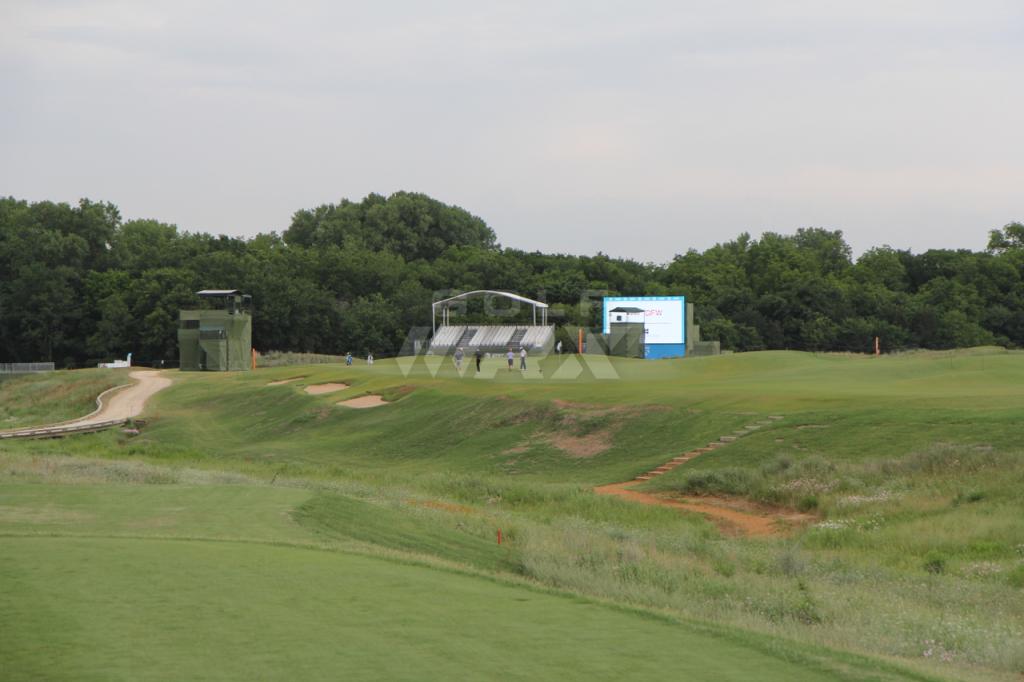Opinion & Analysis
Ari’s Course Reviews: Trinity Forest Golf Club

Editor’s Note: Ari Techner is a well-traveled, golf-course connoisseur who’s setting out to review the best golf courses in the world. The views and opinions expressed in these reviews are his own.
This week, the PGA Tour makes its way to Trinity Forest for the Byron Nelson. Trinity Forest is the newest course played on Tour; it just opened for play in the fall of 2016. The course was designed by Bill Coore and Ben Crenshaw, and the native Texans have created an incredible, links-style course that plays firm and fast, and it requires the golf ball to be played along the ground as much as in the air.
I’ve been lucky enough to play Trinity Forest a number of times now, and I can honestly say it is one of my favorite courses to play in the country. It is filled with variety, angles and strategy and allows me to play similar to how I’d play in Scotland or Ireland, which is the style I prefer to play.

Hole No. 10 at Trinity Forest
Related: Check out our hole-by-hole photos of the front nine and back nine
Most of my favorite courses are built on great sites. Whether it’s along the ocean in California or Oregon, or in the Sand Hills of Nebraska, or along the Sebonak Bay in New York, most of the top courses start with a great piece of real estate. Trinity Forest was the opposite. The course is built on what was an active landfill until the mid 1960s. From the time the landfill closed until they started working on the course in 2014, it was used as an unauthorized dump site for many of the local citizens of South Dallas. You could find all kinds of things on the site including large appliances and boats… there was even an old car on what is now the 17th green.
Building the course was quite the undertaking due to the unique traits of the land. The entire site was capped by the U.S. Army Corp of Engineers with an impenetrable cap, preserving the natural humps and rolls of the property. Then the entire property was covered with a minimum of 2 feet of sand. Due to the cap over the ground, Coore and Crenshaw could not dig down into the ground at all when building the course — they had to build up instead. They basically had to identify the lowest point of the lowest bunker floor and build the entire course up from there. They also could not plant any trees. They were told to make the course long enough for the PGA Tour but were given free reign to design the course how they wanted. This was not a course built with the Tour’s continuous input. The only change the Tour made was to switch the nines from the original design so the tournament finished in front of the clubhouse. This is how the course plays day-to-day now for the members, also.
A new strain of grass was also invented just for the course and the desired firm and fast conditions. Being located in Dallas, the developer and designers knew that the normal warm weather Bermuda or Zoysia would not provide the desired conditions. So they invented what is now called Trinity Zoysia, which is a shallow root Zoysia hybrid that comes very close to imitating the seaside Fescue playing surfaces you see on true links courses.
The resulting course is a modern links gem of the finest order. There are very few places in the USA that you can play an authentic links game and it is shocking to find that one of them in Dallas, Texas.

The tee shot at the par-3 2nd hole
Aside from my obvious enthusiasm for the firm and fast conditions, the course itself is fantastic. It has a tremendous amount of variety and a spectacular set of green complexes. From many places on the course, the best way to get the ball close to the hole is to use the contours of the ground instead of going through the air.
Trinity has one of the best sets of par 3s anywhere. Hole No. 2 plays around 200 yards for the members with a carry over a large bunker that ends 25 yards or so short of the green. The ground tilts to the right and the ideal shot lands short and left of the hole, then chases on and to the right. Hole No. 8 is one of the best super short par 3s in the world. It plays around 100 yards to an incredibly unique green that is split into two bowl-like sections; the left bowl is about twice the size of the tiny right side. The green falls away and to the right at the front, and a golf ball landing short will chase on and stay on the green. The 12th hole plays around 185 yards over a little valley to a green that is long and narrow, and slopes back-to-front and hard right-to-left. The ideal shot is a draw that lands on the right side of the green, or on the short grass right of the green, and uses the contour of the ground to kick onto the green close to the hole. The 17th hole plays about 170 yards for the members to a double-tiered green that slopes hard from front-to-back and right-to-left. If the hole is in the front section, you must land the ball short left of the green and let the ball kick on to get it to stay on that level. To a back hole location, a ball that lands on the front will bound over the hill to the back section. Trinity Forest has a very unique and amazing set of par 3s and it will be very interesting to watch the pros tackle these holes.
As for the five-pars, there will be three of them for the Byron Nelson, and they are all great holes. Hole Nos. 1 and 7 are both mid-length par fives where the optimal line is close to the hazards off the tee. The first hole has a big, round, heavily contoured green, while the 7th green sits on the side of a hill more naturally, but it can be just as devious if you miss in the wrong place. The 14th is one of the best holes on the course and one that has given me fits; it’s a par 5 that plays between 550-600 yards depending on the tee and plays uphill to a fairway that is split in the middle by a nasty, deep large bunker. More bunkers flank the right and left side. The golfer must make a decision as to where to place their tee shot and then pull off the shot as they imagined, or find themselves in a very difficult situation with their second shot. The next shot goes over and down the hill with a ton of room left and more bunkers right. The ideal line is close to the bunkers and the green falls away from front-to-back, but is very deceptive as it doesn’t look like it falls away nearly as much as it does. This is a very tricky green that I have 3 putted, or putted over the green into the bunker, more than I care to admit. A putt from the front of the green to the back looks at first glance to be slightly uphill but plays very much downhill. This is a great example of some of the subtlety at Trinity Forest that will be tough for the players to pickup after only a practice round or two.

The tee shot on hole No. 3 at Trinity Forest
The par 4s are also fantastically varied. Hole No. 3 is a mid-length hole with a bunker cutting sideways directly in the line of play off the tee, and it has a huge, double green shared with the 11th hole. Hole No. 4 is a long hole that plays along a fall off on the right side to a fall away green with danger everywhere. The 5th hole is a world class short hole that plays less than 300 yards to a tiny pushup green set behind an imposing bunker where many people walk away frustrated with a par or much worse. The sixth is one of my favorite holes, with a wide fairway split in the middle by a couple bunkers to a wide green with a false front and fall away in the back half; the strategy off the tee is entirely based on that day’s hole location. Closing out the front nine, hole No. 9 is a very long uphill hole with a fantastic green where the second shot must land right of the green over a couple scary bunkers set about 40 yards short of the green and use the contours to chase your ball onto the green.

Hole No. 12 at Trinity Forest
The back nine opens with a mid-length hole that plays as a slight dogleg right around some really cool, scar-type bunkers with an oval shaped, slightly pushed up green with fantastic contours on and around it. Hole No. 11 plays as a long par 4 for the Byron Nelson but as a 5 for the members. The hole opens up past a couple of fairway bunkers off the tee and plays to the right half of the large green shared by the third hole. This is another green with fantastic internal contouring my favorite of which is the ridge that just rings the right and back edge of the right side of the green and can be used to get the ball close to hole locations on that part of the green. The 13th hole is another long hole that doglegs slightly to the left with a rolling fairway that is interrupted about 125 yards short of the green by a natural grass area and a dirt path. The green tilts from right-to-left with trouble left of the green and short grass right. No. 15 goes uphill off the tee between a couple of bunkers up to a small pushup green with falloff on all sides. The 16th doglegs to the right between some bunkers and has a small, organically-shaped green with a falloff in the back that reminds me of the restoration work Coore/Crenshaw have done at Shinnecock Hills. Lastly, No. 18 is a long and straight hole with a minefield of bunkers along the right side and a green that falls slightly from front-to-back and hard left-to-right. A great finishing hole for the tournament or a casual round between friends.
All-in-all, Trinity Forest is just a fantastic course that promotes everything I love about strategic, firm and fast golf. Bill Coore and Ben Crenshaw deserve MAJOR kudos for creating such and amazing golf course in such an unlikely location. The tournament this week, which I was told will be setup very much like a major championship, will be very unique and exciting to watch and I for one cannot wait to watch it all unfold.
Check out more photos of the course here: Front Nine and the Back Nine
Other Course Reviews from Ari
- LIKE22
- LEGIT3
- WOW3
- LOL4
- IDHT2
- FLOP3
- OB2
- SHANK7
Instruction
The Wedge Guy: The easiest-to-learn golf basic

My golf learning began with this simple fact – if you don’t have a fundamentally sound hold on the golf club, it is practically impossible for your body to execute a fundamentally sound golf swing. I’m still a big believer that the golf swing is much easier to execute if you begin with the proper hold on the club.
As you might imagine, I come into contact with hundreds of golfers of all skill levels. And it is very rare to see a good player with a bad hold on the golf club. There are some exceptions, for sure, but they are very few and very far between, and they typically have beat so many balls with their poor grip that they’ve found a way to work around it.
The reality of biophysics is that the body moves only in certain ways – and the particulars of the way you hold the golf club can totally prevent a sound swing motion that allows the club to release properly through the impact zone. The wonderful thing is that anyone can learn how to put a fundamentally sound hold on the golf club, and you can practice it anywhere your hands are not otherwise engaged, like watching TV or just sitting and relaxing.
Whether you prefer an overlap, interlock or full-finger (not baseball!) grip on the club, the same fundamentals apply. Here are the major grip faults I see most often, in the order of the frequency:
Mis-aligned hands
By this I mean that the palms of the two hands are not parallel to each other. Too many golfers have a weak left hand and strong right, or vice versa. The easiest way to learn how to hold the club with your palms aligned properly is to grip a plain wooden ruler or yardstick. It forces the hands to align properly and shows you how that feels. If you grip and re-grip a yardstick several times, then grip a club, you’ll see that the learning curve is almost immediate.
The position of the grip in the upper/left hand
I also observe many golfers who have the butt of the grip too far into the heel pad of the upper hand (the left hand for right-handed players). It’s amazing how much easier it is to release the club through the ball if even 1/4-1/2″ of the butt is beyond the left heel pad. Try this yourself to see what I mean. Swing the club freely with just your left hand and notice the difference in its release from when you hold it at the end of the grip, versus gripping down even a half inch.
To help you really understand how this works, go to the range and hit shots with your five-iron gripped down a full inch to make the club the same length as your seven-iron. You will probably see an amazing shot shape difference, and likely not see as much distance loss as you would expect.
Too much lower (right) hand on the club
It seems like almost all golfers of 8-10 handicap or higher have the club too far into the palm of the lower hand, because that feels “good” if you are trying to control the path of the clubhead to the ball. But the golf swing is not an effort to hit at the ball – it is a swing of the club. The proper hold on the club has the grip underneath the pad at the base of the fingers. This will likely feel “weak” to you — like you cannot control the club like that. EXACTLY. You should not be trying to control the club with your lower/master hand.
Gripping too tightly
Nearly all golfers hold the club too tightly, which tenses up the forearms and prevents a proper release of the club through impact. In order for the club to move back and through properly, you must feel that the club is controlled by the last three fingers of the upper hand, and the middle two fingers of the lower hand. If you engage your thumbs and forefingers in “holding” the club, the result will almost always be a grip that is too tight. Try this for yourself. Hold the club in your upper hand only, and squeeze firmly with just the last three fingers, with the forefinger and thumb off the club entirely. You have good control, but your forearms are not tense. Then begin to squeeze down with your thumb and forefinger and observe the tensing of the entire forearm. This is the way we are made, so the key to preventing tenseness in the arms is to hold the club very lightly with the “pinchers” — the thumbs and forefingers.
So, those are what I believe are the four fundamentals of a good grip. Anyone can learn them in their home or office very quickly. There is no easier way to improve your ball striking consistency and add distance than giving more attention to the way you hold the golf club.
More from the Wedge Guy
- The Wedge Guy: Golf mastery begins with your wedge game
- The Wedge Guy: Why golf is 20 times harder than brain surgery
- The Wedge Guy: Musings on the golf ball rollback
- LIKE80
- LEGIT13
- WOW4
- LOL1
- IDHT0
- FLOP4
- OB1
- SHANK8
19th Hole
Vincenzi’s 2024 Texas Children’s Houston Open betting preview

As the Florida swing comes to an end, the PGA Tour makes its way to Houston to play the Texas Children’s Houston Open at Memorial Park Golf Course.
This will be the fourth year that Memorial Park Golf Course will serve as the tournament host. The event did not take place in 2023, but the course hosted the event in 2020, 2021 and 2022.
Memorial Park is a par-70 layout measuring 7,432 yards and features Bermudagrass greens. Historically, the main defense for the course has been thick rough along the fairways and tightly mown runoff areas around the greens. Memorial Park has a unique setup that features three Par 5’s and five Par 3’s.
The field will consist of 132 players, with the top 65 and ties making the cut. There are some big names making the trip to Houston, including Scottie Scheffler, Wyndham Clark, Tony Finau, Will Zalatoris and Sahith Theegala.
Past Winners at Memorial Park
- 2022: Tony Finau (-16)
- 2021: Jason Kokrak (-10)
- 2020: Carlos Ortiz (-13)
In this article and going forward, I’ll be using the Rabbit Hole by Betsperts Golf data engine to develop my custom model. If you want to build your own model or check out all of the detailed stats, you can sign up using promo code: MATTVIN for 25% off any subscription package (yearly is best value).
Key Stats For Memorial Park
Let’s take a look at several metrics for Memorial Park to determine which golfers boast top marks in each category over their last 24 rounds:
Strokes Gained: Approach
Memorial Park is a pretty tough golf course. Golfers are penalized for missing greens and face some difficult up and downs to save par. Approach will be key.
Total Strokes Gained: Approach per round in past 24 rounds:
- Tom Hoge (+1.30)
- Scottie Scheffler (+1.26)
- Keith Mitchell (+0.97)
- Tony Finau (+0.92)
- Jake Knapp (+0.84)
Strokes Gained: Off the Tee
Memorial Park is a long golf course with rough that can be penal. Therefore, a combination of distance and accuracy is the best metric.
Total Strokes Gained: Off the Tee per round in past 24 rounds:
- Scottie Scheffler (+0.94)
- Kevin Dougherty (+0.93)
- Cameron Champ (+0.86)
- Rafael Campos (+0.84)
- Si Woo Kim (+0.70)
Strokes Gained Putting: Bermudagrass + Fast
The Bermudagrass greens played fairly fast the past few years in Houston. Jason Kokrak gained 8.7 strokes putting on his way to victory in 2021 and Tony Finau gained in 7.8 in 2022.
Total Strokes Gained Putting (Bermudagrass) per round past 24 rounds (min. 8 rounds):
- Adam Svensson (+1.27)
- Harry Hall (+1.01)
- Martin Trainer (+0.94)
- Taylor Montgomery (+0.88)
- S.H. Kim (+0.86)
Strokes Gained: Around the Green
With firm and undulating putting surfaces, holding the green on approach shots may prove to be a challenge. Memorial Park has many tightly mowed runoff areas, so golfers will have challenging up-and-down’s around the greens. Carlos Ortiz gained 5.7 strokes around the green on the way to victory in 2020.
Total Strokes Gained: Around the Green per round in past 24 rounds:
- Mackenzie Hughes (+0.76)
- S.H. Kim (+0.68)
- Scottie Scheffler (+0.64)
- Jorge Campillo (+0.62)
- Jason Day (+0.60)
Strokes Gained: Long and Difficult
Memorial Park is a long and difficult golf course. This statistic will incorporate players who’ve had success on these types of tracks in the past.
Total Strokes Gained: Long and Difficult in past 24 rounds:
- Scottie Scheffler (+2.45)
- Ben Griffin (+1.75)
- Will Zalatoris (+1.73)
- Ben Taylor (+1.53)
- Tony Finau (+1.42)
Course History
Here are the players who have performed the most consistently at Memorial Park.
Strokes Gained Total at Memorial Park past 12 rounds:
- Tyson Alexander (+3.65)
- Ben Taylor (+3.40)
- Tony Finau (+2.37)
- Joel Dahmen (+2.25)
- Patton Kizzire (+2.16)
Statistical Model
Below, I’ve reported overall model rankings using a combination of the five key statistical categories previously discussed.
These rankings are comprised of SG: App (24%) SG: OTT (24%); SG: Putting Bermudagrass/Fast (13%); SG: Long and Difficult (13%); SG: ARG (13%) and Course History (13%)
- Scottie Scheffler
- Wyndham Clark
- Tony Finau
- Joel Dahmen
- Stephan Jaeger
- Aaron Rai
- Sahith Theegala
- Keith Mitchell
- Jhonnatan Vegas
- Jason Day
- Kurt Kitayama
- Alex Noren
- Will Zalatoris
- Si Woo Kim
- Adam Long
2024 Texas Children’s Houston Open Picks
Will Zalatoris +2000 (Caesars)
Scottie Scheffler will undoubtedly be difficult to beat this week, so I’m starting my card with someone who I believe has the talent to beat him if he doesn’t have his best stuff.
Will Zalatoris missed the cut at the PLAYERS, but still managed to gain strokes on approach while doing so. In an unpredictable event with extreme variance, I don’t believe it would be wise to discount Zalatoris based on that performance. Prior to The PLAYERS, the 27-year-old finished T13, T2 and T4 in his previous three starts.
Zalatoris plays his best golf on long and difficult golf courses. In his past 24 rounds, he ranks 3rd in the category, but the eye test also tells a similar story. He’s contended at major championships and elevated events in the best of fields with tough scoring conditions. The Texas resident should be a perfect fit at Memorial Park Golf Club.
Alex Noren +4500 (FanDuel)
Alex Noren has been quietly playing some of his best golf of the last half decade this season. The 41-year-old is coming off back-to-back top-20 finishes in Florida including a T9 at The PLAYERS in his most recent start.
In his past 24 rounds, Noren ranks 21st in the field in Strokes Gained: Off the Tee, 30th in Strokes Gained: Around the Green, 25th in Strokes Gained: Total on long and difficult courses and 21st in Strokes Gained: Putting on fast Bermudagrass greens.
In addition to his strong recent play, the Swede also has played well at Memorial Park. In 2022, Noren finished T4 at the event, gaining 2.2 strokes off the tee and 7.0 strokes on approach for the week. In his two starts at the course, he’s gained an average of .6 strokes per round on the field, indicating he is comfortable on these greens.
Noren has been due for a win for what feels like an eternity, but Memorial Park may be the course that suits him well enough for him to finally get his elusive first PGA Tour victory.
Mackenzie Hughes +8000 (FanDuel)
Mackenzie Hughes found himself deep into contention at last week’s Valspar Championship before faltering late and finishing in a tie for 3rd place. While he would have loved to win the event, it’s hard to see the performance as anything other than an overwhelming positive sign for the Canadian.
Hughes has played great golf at Memorial Park in the past. He finished T7 in 2020, T29 in 2021 and T16 in 2022. The course fit seems to be quite strong for Hughes. He’s added distance off the tee in the past year or and ranks 8th in the field for apex height, which will be a key factor when hitting into Memorial Park’s elevated greens with steep run-off areas.
In his past 24 rounds, Hughes is the best player in the field in Strokes Gained: Around the Greens. The ability to scramble at this course will be extremely important. I believe Hughes can build off of his strong finish last week and contend once again to cement himself as a President’s Cup consideration.
Akshay Bhatia +8000 (FanDuel)
Akshay Bhatia played well last week at the Valspar and seemed to be in total control of his golf ball. He finished in a tie for 17th and shot an impressive -3 on a difficult Sunday. After struggling Thursday, Akshay shot 68-70-68 in his next three rounds.
Thus far, Bhatia has played better at easier courses, but his success at Copperhead may be due to his game maturing. The 22-year-old has enormous potential and the raw talent to be one of the best players in the world when he figures it all out.
Bhatia is a high upside play with superstar qualities and may just take the leap forward to the next stage of his career in the coming months.
Cameron Champ +12000 (FanDuel)
Cameron Champ is a player I often target in the outright betting market due to his “boom-or-bust” nature. It’s hard to think of a player in recent history with three PGA Tour wins who’s been as inconsistent as Champ has over the course of his career.
Despite the erratic play, Cam Champ simply knows how to win. He’s won in 2018, 2019 and 2021, so I feel he’s due for a win at some point this season. The former Texas A&M product should be comfortable in Texas and last week he showed us that his game is in a pretty decent spot.
Over his past 24 rounds, Champ ranks 3rd in Strokes Gained: Off the Tee and 30th in Strokes Gained: Total on long and difficult courses. Given his ability to spike at any given time, Memorial Park is a good golf course to target Champ on at triple digit odds.
Robert MacIntyre +12000 (FanDuel)
The challenge this week is finding players who can possibly beat Scottie Scheffler while also not dumping an enormous amount of money into an event that has a player at the top that looks extremely dangerous. Enter McIntyre, who’s another boom-or-bust type player who has the ceiling to compete with anyone when his game is clicking on all cylinders.
In his past 24 rounds, MacIntyre ranks 16th in the field in Strokes Gained: Off the Tee, 17th in Strokes Gained: Around the Green and 10th in Strokes Gained: Total on long and difficult courses.
MacIntyre’s PGA Tour season has gotten off to a slow start, but he finished T6 in Mexico, which is a course where players will hit driver on the majority of their tee shots, which is what we will see at Memorial Park. Texas can also get quite windy, which should suit MacIntyre. Last July, the Scot went toe to toe with Rory McIlroy at the Scottish Open before a narrow defeat. It would take a similar heroic effort to compete with Scheffler this year in Houston.
Ryan Moore +15000 (FanDuel)
Ryan Moore’s iron play has been absolutely unconscious over his past few starts. At The PLAYERS Championship in a loaded field, he gained 6.1 strokes on approach and last week at Copperhead, he gained 9.0 strokes on approach.
It’s been a rough handful of years on Tour for the 41-year-old, but he is still a five-time winner on the PGA Tour who’s young enough for a career resurgence. Moore has chronic deterioration in a costovertebral joint that connects the rib to the spine, but has been getting more consistent of late, which is hopefully a sign that he is getting healthy.
Veterans have been contending in 2024 and I believe taking a flier on a proven Tour play who’s shown signs of life is a wise move at Memorial Park.
- LIKE15
- LEGIT1
- WOW1
- LOL0
- IDHT0
- FLOP0
- OB0
- SHANK2
Opinion & Analysis
Ryan: Why the race to get better at golf might be doing more harm than good

B.F. Skinner was one of the most important psychologists of the 20th century, developing the foundation of the development of reinforcement, and in doing so, creating the concept of behaviorism. In simple terms, this means that we are conditioned by our habits. In practical terms, it explains the divide between the few and far between elite instructors and college coaches.
To understand the application, let’s quickly review one of B.F. Skinner’s most important experiments; superstitions in the formation of behavior by pigeons. In this experiment, food was dispensed to pigeons at random intervals. Soon, according to Skinner, the pigeons began to associate whatever action they were doing at the time of the food being dispensed. According to Skinner, this conditioned that response and soon, they simply haphazardly repeated the action, failing to distinguish between cause and correlation (and in the meantime, looking really funny!).
Now, this is simply the best way to describe the actions of most every women’s college golf coach and too many instructors in America. They see something work, get positive feedback and then become conditioned to give the feedback, more and more, regardless of if it works (this is also why tips from your buddies never work!).
Go to a college event, particularly a women’s one, and you will see coaches running all over the place. Like the pigeons in the experiment, they have been conditioned into a codependent relationship with their players in which they believe their words and actions, can transform a round of golf. It is simply hilarious while being equally perturbing
In junior golf, it’s everywhere. Junior golf academies make a living selling parents that a hysterical coach and over-coaching are essential ingredients in your child’s success.
Let’s be clear, no one of any intellect has any real interest in golf — because it’s not that interesting. The people left, including most coaches and instructors, carve out a small fiefdom, usually on the corner of the range, where they use the illusion of competency to pray on people. In simple terms, they baffle people with the bullshit of pseudo-science that they can make you better, after just one more lesson.
The reality is that life is an impromptu game. The world of golf, business, and school have a message that the goal is being right. This, of course, is bad advice, being right in your own mind is easy, trying to push your ideas on others is hard. As a result, it is not surprising that the divorce rate among golf professionals and their instructors is 100 percent. The transfer rate among college players continues to soar, and too many courses have a guy peddling nefarious science to good people. In fact, we do at my course!
The question is, what impact does all this have on college-age and younger kids? At this point, we honestly don’t know. However, I am going to go out on a limb and say it isn’t good.
Soren Kierkegaard once quipped “I saw it for what it is, and I laughed.” The actions of most coaches and instructors in America are laughable. The problem is that I am not laughing because they are doing damage to kids, as well as driving good people away from this game.
The fact is that golfers don’t need more tips, secrets, or lessons. They need to be presented with a better understanding of the key elements of golf. With this understanding, they can then start to frame which information makes sense and what doesn’t. This will emancipate them and allow them to take charge of their own development.
- LIKE14
- LEGIT4
- WOW1
- LOL2
- IDHT0
- FLOP1
- OB0
- SHANK11
-

 19th Hole1 week ago
19th Hole1 week agoJohn Daly stuns fans into silence with brutal opening tee shot on PGA Tour Champions
-

 19th Hole2 weeks ago
19th Hole2 weeks ago2-time major champ announces shock retirement from the sport at age of 33
-

 19th Hole1 week ago
19th Hole1 week agoCharlie Woods finds it tough going on American Junior Golf Association debut
-

 19th Hole2 weeks ago
19th Hole2 weeks agoEdoardo Molinari reveals the latest PGA Tour golfer to turn down ‘good offer’ from LIV Golf
-

 Equipment3 weeks ago
Equipment3 weeks agoBest driver 2024: The best driver for you, as recommend by expert club fitters
-

 19th Hole2 weeks ago
19th Hole2 weeks agoScottie Scheffler had an interesting response when asked how he ‘quiets the noise’ following Players victory
-

 19th Hole2 weeks ago
19th Hole2 weeks agoJon Rahm dealt fresh blow to hopes of qualifying for 2025 Ryder Cup
-

 19th Hole22 hours ago
19th Hole22 hours agoThings got heated at the Houston Open between Tony Finau and Alejandro Tosti. Here’s why




















